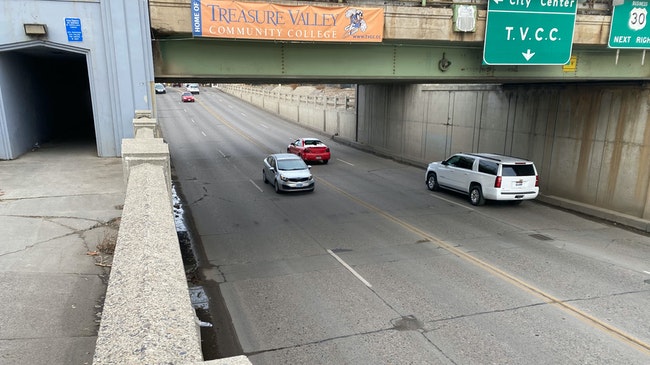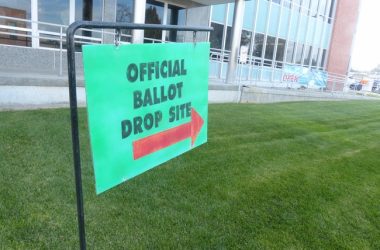 T
T
he East Idaho Avenue underpass in downtown Ontario, patched over and over, is a top priority for repairs that could be speeded along with recent extra federal allocations. (The Enterprise/LES ZAITZ)
ONTARIO – No engineering degree is needed to know East Idaho Avenue needs help as it courses beneath the Union Pacific Railroad tracks.
The pavement is cracked and patched in one place after another.
Recent action by Congress and President Joe Biden means repairs to one of Ontario’s main streets could happen sooner than expected.
Money will flow from the federal Infrastructure Investment and Jobs Act, which directs several billion dollars to Oregon for fixing roads, bridges, water systems and more.
City Manager Adam Brown said Ontario is in a good position to take advantage of the infusion.
“The city council has been really aggressive in engineering projects,” Brown said. “We’re well aligned with what they funded.”
And the Idaho Avenue underpass is on the city’s priority list. The pavement condition for engineering purposes is rated “poor.” Other improvements could be made in what Brown said would be a “major project.”
Malheur County Judge Dan Joyce said repairing some bridges in the county “would be a top priority.”
He said Malheur County’s share of federal money will depend on what road and bridge projects it has – and what the regional transportation advisory committee recommends for southeast Oregon.
Dave Tiffany, manager of the Malheur County Road Department, said he hadn’t learned details of the potential funding but said county roads are generally in good shape.
Those governments that already have projects on the drawing boards are likely to get money first.
Jim McCauley of the League of Oregon Cities said the association is advising cities to consider which projects are closest to being ready for construction.
“Can you get a shovel in the ground in 12 months or is this going to take you a couple of years,” he said.
McCauley said the federal infusion comes on top of an aggressive state allocation for road and bridge projects. He said state agencies are sorting out now how to award the money, which should start flowing next year.
“The biggest thing is to be patient” while those details are sorted, McCauley said.
He expects local governments will get a share of the federal money based on proven need.
“My sense is this is going to be less of a political decision-making process,” he said.
Meantime, local governments should be setting priorities if they haven’t already.
Brown said Ontario has done that.
On the list is rebuilding Southeast Second Avenue where it reaches the Americold and Kraft Heinz plants north of Idaho Avenue. The street is “failing” and needs to be “totally rebuilt,” Brown said.
He said the city already has $2 million set aside for a project that could be expanded with federal money – improving sidewalks along Southeast Fifth Avenue from South Oregon Street east to East Lane.
Other projects could include extending water and sewer services to several locations in Ontario, adding turn lanes on East Idaho Avenue, and building a second bridge over the Snake River to connect Ontario to Idaho.
U.S. Rep. Cliff Bentz, the Republican representing Malheur County in Congress, voted against the infrastructure funding but his staff said he would nonetheless help those who want to get a share of it.
“The Congressman, should he be asked, and should the facts warrant, would write letters of support for grant applications,” according to an email from Nick Clemens, Bentz’s communications director in Washington.
Clemens said Bentz opposed the funding legislation because it put too much money into passenger rail and the Green New Deal program, including money for electric charging stations.
“Has the federal government ever paid for gas stations?” Clemens asked.
He said Bentz thought the legislation was “ignoring the incredible need for repair of roads and bridges.”
The National Association of Counties calculated that $110 billion was allocated for new spending on roads and bridges with $7.5 billion budgeted electric charging stations.
Clemens also said Bentz objected that the spending plan was crafted in the Senate without input from House Republicans.
A bipartisan Senate team finalized the legislation and it passed the Senate with Republican votes. In the House, 13 Republicans voted for the package.
The Senate team included U.S. Sens. Rob Portman, R-Ohio, Susan Collins, R-Maine, Mitt Romney, R-Utah, Lisa Murkowski, R-Alaska, Bill Cassidy, R-Louisiana, Kyrsten Sinema, D-Arizona, Joe Manchin, D-West Virginia, Mark Warner, D-Virginia, Jeanne Shaheen, D-New Hampshire, and Jon Tester, D-Montana.
EXCELLENCE IN JOURNALISM – Available for $5 a month. Subscribe to the digital service of the Enterprise and get the very best in local journalism. We report with care, attention to accuracy, and an unwavering devotion to fairness. Get the kind of news you’ve been looking for – day in and day out from the Enterprise.




